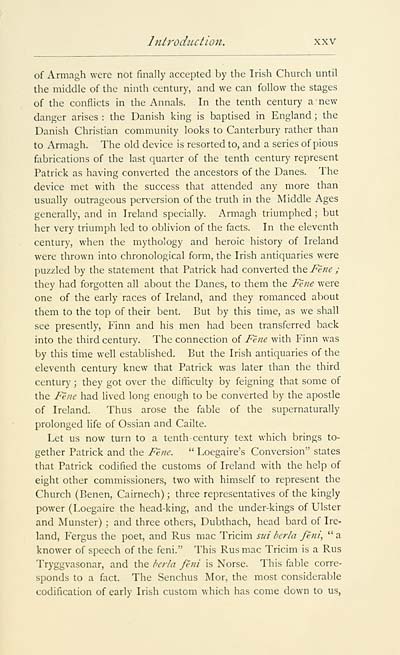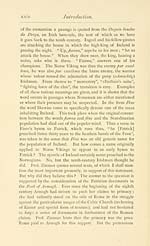Download files
Complete book:
Individual page:
Thumbnail gallery: Grid view | List view

Introduction.
of Armagh were not finally accepted by the Irish Church until
the middle of the ninth century, and we can follow the stages
of the conflicts in the Annals. In the tenth century a new
danger arises : the Danish king is baptised in England ; the
Danish Christian community looks to Canterbury rather than
to Armagh. The old device is resorted to, and a series of pious
fabrications of the last quarter of the tenth century represent
Patrick as having converted the ancestors of the Danes. The
device met with the success that attended any more than
usually outrageous perversion of the truth in the Middle Ages
generally, and in Ireland specially. Armagh triumphed ; but
her very triumph led to oblivion of the facts. In the eleventh
century, when the mythology and heroic history of Ireland
were thrown into chronological form, the Irish antiquaries were
puzzled by the statement that Patrick had converted the Fetie ;
they had forgotten all about the Danes, to them the Fe7ie were
one of the early races of Ireland, and they romanced about
them to the top of their bent. But by this time, as we shall
see presently, Finn and his men had been transferred back
into the third century. The connection of Fene with Finn was
by this time well established. But the Irish antiquaries of the
eleventh century knew that Patrick was later than the third
century ; they got over the difficulty by feigning that some of
the Fene had lived long enough to be converted by the apostle
of Ireland. Thus arose the fable of the supernaturally
prolonged life of Ossian and Cailte.
Let us now turn to a tenth-century text which brings to-
gether Patrick and the Fene. " Loegciire's Conversion" states
that Patrick codified the customs of Ireland with the help of
eight other commissioners, two with himself to represent the
Church (Benen, Cairnech) ; three representatives of the kingly
power (Loegaire the head-king, and the under-kings of Ulster
and Munster) ; and three others, Dubthach, head bard of Ire-
land, Fergus the poet, and Rus mac Tricim sui berla feni, " a
knower of speech of the feni." This Rus mac Tricim is a Rus
Tryggvasonar, and the f>erla feni is Norse. This fable corre-
sponds to a fact. The Senchus Mor, the most considerable
codification of early Irish custom which has come down to us,
of Armagh were not finally accepted by the Irish Church until
the middle of the ninth century, and we can follow the stages
of the conflicts in the Annals. In the tenth century a new
danger arises : the Danish king is baptised in England ; the
Danish Christian community looks to Canterbury rather than
to Armagh. The old device is resorted to, and a series of pious
fabrications of the last quarter of the tenth century represent
Patrick as having converted the ancestors of the Danes. The
device met with the success that attended any more than
usually outrageous perversion of the truth in the Middle Ages
generally, and in Ireland specially. Armagh triumphed ; but
her very triumph led to oblivion of the facts. In the eleventh
century, when the mythology and heroic history of Ireland
were thrown into chronological form, the Irish antiquaries were
puzzled by the statement that Patrick had converted the Fetie ;
they had forgotten all about the Danes, to them the Fe7ie were
one of the early races of Ireland, and they romanced about
them to the top of their bent. But by this time, as we shall
see presently, Finn and his men had been transferred back
into the third century. The connection of Fene with Finn was
by this time well established. But the Irish antiquaries of the
eleventh century knew that Patrick was later than the third
century ; they got over the difficulty by feigning that some of
the Fene had lived long enough to be converted by the apostle
of Ireland. Thus arose the fable of the supernaturally
prolonged life of Ossian and Cailte.
Let us now turn to a tenth-century text which brings to-
gether Patrick and the Fene. " Loegciire's Conversion" states
that Patrick codified the customs of Ireland with the help of
eight other commissioners, two with himself to represent the
Church (Benen, Cairnech) ; three representatives of the kingly
power (Loegaire the head-king, and the under-kings of Ulster
and Munster) ; and three others, Dubthach, head bard of Ire-
land, Fergus the poet, and Rus mac Tricim sui berla feni, " a
knower of speech of the feni." This Rus mac Tricim is a Rus
Tryggvasonar, and the f>erla feni is Norse. This fable corre-
sponds to a fact. The Senchus Mor, the most considerable
codification of early Irish custom which has come down to us,
Set display mode to: Large image | Transcription
Images and transcriptions on this page, including medium image downloads, may be used under the Creative Commons Attribution 4.0 International Licence unless otherwise stated. ![]()
| Early Gaelic Book Collections > Ossian Collection > Waifs and strays of Celtic tradition > Volume 4 > (31) |
|---|
| Permanent URL | https://digital.nls.uk/82446300 |
|---|
| Description | IV. The Fians, Gaelic & English. |
|---|---|
| Shelfmark | Oss.279 |
| Attribution and copyright: |
|
| Description | Selected books from the Ossian Collection of 327 volumes, originally assembled by J. Norman Methven of Perth. Different editions and translations of James MacPherson's epic poem 'Ossian', some with a map of the 'Kingdom of Connor'. Also secondary material relating to Ossianic poetry and the Ossian controversy. |
|---|
| Description | Selected items from five 'Special and Named Printed Collections'. Includes books in Gaelic and other Celtic languages, works about the Gaels, their languages, literature, culture and history. |
|---|

